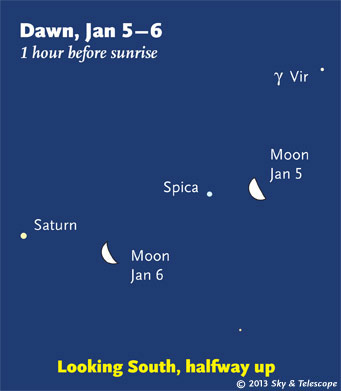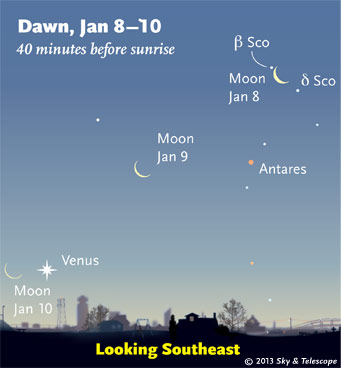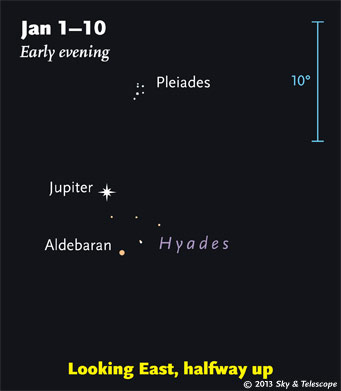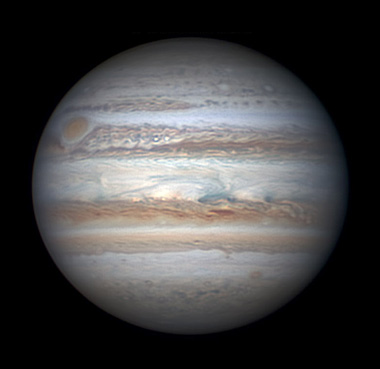
With dawn coming its latest at this time of year, take a look outside for the waning Moon passing Spica and Saturn. (The Moon is positioned for the middle of North America. In Europe, move the Moon symbols a quarter of the way toward the one for the previous date.)
Sky & Telescope diagram
Friday, January 4
Saturday, January 5
Sunday, January 6

The waning crescent Moon appears lower each morning until dawn on Thursday, when it forms a spectacular pair with Venus very low in the southeast.
Sky & Telescope diagram
Monday, January 7
Tuesday, January 8
Wednesday, January 9
Thursday, January 10
Friday, January 11
Saturday, January 12
Want to become a better amateur astronomer? Learn your way around the constellations. They're the key to locating everything fainter and deeper to hunt with binoculars or a telescope.
For an easy-to-use constellation guide covering the whole evening sky, use the big monthly map in the center of each issue of Sky & Telescope diagram" target="new_window">Sky & Telescope, the essential guide to astronomy. Or download our free Getting Started in Astronomy booklet (which only has bimonthly maps).

The Pocket Sky Atlas plots 30,796 stars to magnitude 7.6 — which may sound like a lot, but that's less than one star in an entire telescopic field of view, on average. By comparison, Sky Atlas 2000.0 plots 81,312 stars to magnitude 8.5, typically one or two stars per telescopic field. Both atlases include many hundreds of deep-sky targets — galaxies, star clusters, and nebulae — to hunt among the stars.
Sky & Telescope
Once you get a telescope, to put it to good use you'll need a detailed, large-scale sky atlas (set of charts). The standards are the little Pocket Sky Atlas, which shows stars to magnitude 7.6; the larger and deeper Sky Atlas 2000.0 (stars to magnitude 8.5); and the even larger Uranometria 2000.0 (stars to magnitude 9.75). And read how to use sky charts with a telescope effectively.
You'll also want a good deep-sky guidebook, such as Sue French's Deep-Sky Wonders collection (which includes its own charts), Sky Atlas 2000.0 Companion by Strong and Sinnott, the bigger Night Sky Observer's Guide by Kepple and Sanner, or the beloved if dated Burnham's Celestial Handbook.
Can a computerized telescope replace charts? Not for beginners, I don't think, and certainly not on mounts and tripods that are less than top-quality mechanically (able to point with better than 0.2° repeatability). As Terence Dickinson and Alan Dyer say in their invaluable Backyard Astronomer's Guide, "A full appreciation of the universe cannot come without developing the skills to find things in the sky and understanding how the sky works. This knowledge comes only by spending time under the stars with star maps in hand."
This Week's Planet Roundup

Watch Jupiter gradually creeping toward a better lineup between Aldebaran and the Pleiades. It won't quite get there, however. Instead it will gradually stop and reverse direction at the end of January, just short of forming a straight line. (The 10° scale is about the width of your fist held at arm's length.)
Sky & Telescope diagram
Mercury is hidden in the glare of the Sun.
Venus (magnitude –3.9) appears lower in the dawn each morning. Look for it above the southeast horizon about 45 minutes before your local sunrise.
Mars (magnitude +1.2, in Sagittarius) still glimmers low in the southwest in the fading glow of sunset. Don't confuse it with Fomalhaut far to its left.
Jupiter (magnitude –2.7, in Taurus) is the first "star" to come out in the eastern sky after sundown. It climbs to dominate the high southeastern sky after dark, with orange Aldebaran below it and the Pleiades above it. Jupiter passes highest in the south around 9 p.m. local time. In a telescope it's still a big 47 or 46 arcseconds wide.
Saturn (magnitude +0.6, in Libra) rises in the east-southeast around 2 a.m. local time. By the beginning of dawn it's fairly high in the southeast. That's the best time to get your telescope on it. Saturn's rings are tilted 19° to our line of sight, the widest open they've been in seven years.

The white turbulence following Jupiter's Great Red Spot, and unusual amounts of activity in the Equatorial Zone, are evident in this exquisite image taken on January 1st by Christopher Go in the Philippines. South is up.
Uranus (magnitude 5.8, in Pisces) is still in good view in the southwest right after dark. Finder chart.
Neptune (magnitude 8.0, in Aquarius) is sinking away low in the west-southwest after dark.
All descriptions that relate to your horizon — including the words up, down, right, and left — are written for the world's mid-northern latitudes. Descriptions that also depend on longitude (mainly Moon positions) are for North America. Eastern Standard Time (EST) equals Universal Time (also known as UT, UTC, or GMT) minus 5 hours.
Like This Week's Sky at a Glance? Watch our SkyWeek TV short. It's also playing on PBS!
To be sure to get the current Sky at a Glance, bookmark this URL:
http://SkyandTelescope.com/observing/ataglance?1=1
If pictures fail to load, refresh the page. If they still fail to load, change the 1 at the end of the URL to any other character and try again.
 0
0
Comments
You must be logged in to post a comment.